Galashiels: Difference between revisions
Created page with '{{Infobox town |name=Galashiels |county=Selkirkshire |picture=Church spires in Galashiels - geograph.org.uk - 717309.jpg |picture caption=View over Galashiels |population =12,367…' |
|||
| Line 34: | Line 34: | ||
**St Aidan's | **St Aidan's | ||
**St Ninian's | **St Ninian's | ||
*Baptist: [www.galashielsbaptistchurch.org.uk/ Galashiels Baptist Church] | *Baptist: [http://www.galashielsbaptistchurch.org.uk/ Galashiels Baptist Church] | ||
*Episcopal: [http://www.stpetersgala.co.uk/ St Peter's] | *Episcopal: [http://www.stpetersgala.co.uk/ St Peter's] | ||
*Independent: Tweedbank Community Church | *Independent: Tweedbank Community Church | ||
Revision as of 22:35, 2 April 2014
| Galashiels | |
| Selkirkshire | |
|---|---|
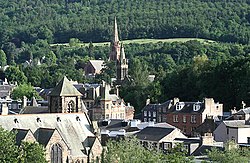 View over Galashiels | |
| Location | |
| Grid reference: | NT495365 |
| Location: | 55°37’10"N, 2°48’12"W |
| Data | |
| Population: | 12,367 |
| Post town: | Galashiels |
| Postcode: | TD1 |
| Dialling code: | 01896 |
| Local Government | |
| Council: | Scottish Borders |
| Parliamentary constituency: |
Berwickshire, Roxburgh and Selkirk |
Galashiels is a town and burgh in Selkirkshire. The town stands on the Gala Water river. Locally the name is frequently abbreviated to "Gala". It is a wee town in the heart of the Tweed Valley, with a population in 2001 of just 12,367. It has not been well discovered by tourists but offers those who come a fine location, views and parks as well as practical shopping facilities.
Galashiels is also a major commercial centre and central communication point for the region. The town is known for textile manufacturing, and is the location of Heriot-Watt University's School of Textiles and Design.
The town
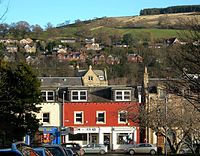
Channel Street is considered the main shopping street and has a pedestrian precinct and other traffic calming measures to ensure shopping in the town is a pleasurable experience. Most visitors will appreciate Bank Street gardens situated in the town centre. There is an award-winning war memorial by Robert Lorimer constructed in the style of a Peel Tower fronted by a statue of a Border Reiver.
Galashiels also has a multi-screen cinema on Market Street and along with several restaurants and night-clubs gives Galashiels a very urban and city-like feel despite its comparatively small population
The Old Town
Now a mixture of housing and a busy thoroughfare through town, this part of Galashiels has a market or Mercat Cross and is surrounded by remnants of the town's history, with a former cloth hall, the Gala Aisle, Tea Street in the neighbouring area.
Churches
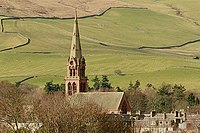
- Church of Scotland:
- Old Parish & St Paul's
- St John's
- St Aidan's
- St Ninian's
- Baptist: Galashiels Baptist Church
- Episcopal: St Peter's
- Independent: Tweedbank Community Church
- United Reformed Church: Galashiels United Reformed Church
- Roman Catholic: Our Lady & St Andrew
A rare Glasite church stands somewhat hidden, sandwiched between mills and shop buildings on High Street, Botany Lane and Roxburgh Street. It is in danger of being lost to neglect.[1]
History
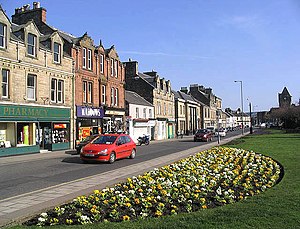
To the west of the town there is an ancient earthwork known as the Picts' Work Ditch or Catrail. It extends many miles south and its height and width varies. There is no agreement about the purpose of the earthwork. Another ancient site on the north-western edge of the town, at Torwoodlee, is an Iron Age hill fort, with a later broch built in the Western quarter of the hill fort, and overlapping some of the defensive ditches of the original fort. The Romans destroyed the broch in AD 140, soon after it was completed.
The burgh's arms shows two foxes reaching up to eat plums from a tree, and the motto is Sour Plums.[2] It is a reference to an incident in 1337 when a party of English soldiers were picking wild plums close to the town and were caught by Scots who slaughtered them all.
On a hillside to the north of the town, Buckholm Tower is a prominent structure which dates back to 1582 and replaced another tower built on the same site but destroyed around 1570.
In 1599 Galashiels received its burgh Charter, an event celebrated every summer since the 1930s by the "Braw Lads Gathering" with riders on horseback parading through the town.
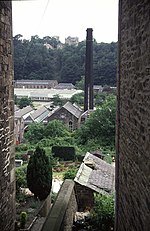
Galashiels' population grew fast with through the textile trade with several mills. A connection with the town's mill history, the Mill Lade, still links the town from near the site of mills at Wheatlands Road, to Netherdale.
In culture
Robert Burns wrote two poems about Galashiels, "Sae Fair Her Hair" and "Braw Lads". The latter is sung by the some of the townsfolk each year at the Braw Lads Gathering. Sir Walter Scott built his home, Abbotsford, just across the River Tweed from Galashiels. The "Sir Walter Scott Way", a long-distance path from Moffat to Cockburnspath, passes through Galashiels.
There is some largely good-hearted rivalry between some of the Galashiels townsfolk and those of other towns hereabouts, particularly Hawick, the largest town in the area. Galashiels's citizens often refer to their rival as dirty Hawick while the 'Teries' retort that Galashiels's residents are pail merks, supposedly because their town was the last to be plumbed into the mains water system and so residents had to rely on buckets as toilets.[3]
A tourism guide, based on the experiences of travellers, once described Galashiels as a place "which is hard to avoid" due to it being a transport hub and centrally based in the Borders and being "unwelcoming during the day" and having an "air of menace" about it at night. Itr seems a harsh reflection on what is a pretty Selkirkshire town.
Galashiels was also home to the author of the famous Scottish song, "Coulters Candy". Robert Coltart was a weaver in the town, but made confectionery also in near-by Melrose. The song was created as an advertisement, and hence was renamed as "Sugar Candy" when played by the BBC. The song is possibly better known by the first line of its chorus - "Ally, bally, ally bally bee". Coltart died in 1890.
References
- ↑ http://www.buildingsatrisk.org.uk/BAR/detail.aspx?sctID=1020®ion=Scottish%20Borders&div=&class=REL&category=ALL&Page=1&NumImg=5
- ↑ John Ruskin (1907). The Works of John Ruskin. Longmans, Green, and co.. pp. 613.
- ↑ Scottish Voices Project
- "Census 2001". Population figures. http://www.scotborders.gov.uk/outabout/aboutborders/townsize/index.html. Retrieved August 17, 2005.
- "BBC Voices Recording/Scottish Corpus". http://www.scottishcorpus.ac.uk/corpus/search/document.php?documentid=1572. Retrieved January 4, 2009.
- "Waverley Rail Project". Rail work figures. http://www.waverleyrailwayproject.co.uk. Retrieved October 2, 2009.